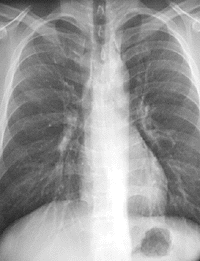Cardiothoracic Imaging in Disease
A Guided Tour
Based on CV 40 (Cardiac Imaging: Radiology and Echocardiography) and RS 35/36 (Role of Imaging and Respiratory Disease I and II)
Refs: Cecil pps. 20-22, 28, CV 05/RS 10 (Radiology of the Thorax)
Luckily, there isn't much of a big secret to imaging. Your best friends are solid knowledge of regular anatomy and the pathophysiology of nasty thoracic diseases.
 |
Let's take a look at a normal chest X-ray, since it's kinda hard to say what's abnormal without a starting reference point.
Ok, so what have we got here?
Well, without meaning to be too basic, all 4 densities are clearly visible, and the image is anatomically and physiologically normal. Everything is where it should be, looking the way it should look:
In case you forgot, the 4 densities visible on plane X-ray are:
- AIR - black (e.g. aerated lung fields)
- FAT - black (e.g. retroperitoneal abdominal fat)
- WATER - white (e.g. blood, fluid, pus, soft tissue organs)
- BONE - white (e.g. clavicles, ribs)
|
- Clavicles:
- in line, the same size, and symmetrical. Distance from spinous processes to medial border of the clavicles is equal.
- Ribs:
- exhibit symmetry, aesthetic curvature, no unusual densities, cracks or worn off areas (as in chronic, uncontrolled hypertension)
- Spine:
- no lateral curvature, normal spinous processes and intercalated discs. Adequate penetration is indicated because thoracical vertebral bodies are visualized on the frontal film.
- Lungs:
- well-aereated with equal pulmonary vasculature (left to right) and normal preferential vasculature distribution to the lower lung fields. Normal height (R1 to R9 on right and R1 to R10 on left). Inspiratory effort was adequate (at least 6 ribs are visualized).
- Trachea:
- directly anterior the spine (not deviating right or left), bifurcating centrally at the carina, no unusual masses or stenosis present
- Sternum:
- central and symmetrical
- Heart border:
- less than 50% of lateral thoracic diameter, border fully visible (not obscured), normal shape, size, and location, no evidence of deviation right or left. Vertical extent R5 to R9. Horizontal extent within left mid-clavicular line.
- The great vessels:
- normally located hilar vessels, cavae and aorta, four cardiac moguls normal (aortic arch, pulmonary arteries, left atrium, left ventricle).
- Diaphragm:
- Sharp border with lung, nice and round, sharp costophrenic angles (unfortunately cut off in this picture), one intercostal space higher on the right than on the left diaphragm. Stomach bubble visible on the left.
So much for our tour of normal!
As physicians, we aren't on the lookout for the normal (usually), and the key benefit of the x-ray is its power to reveal the abnormal, thus including or excluding certain diagnoses in concert with a good history, physical, and lab findings.
Rather than hammer you with a zillion x-rays, let's take a look at a really classic presentation from each of the general pulmonary and cardiac disease categories we've studied this term. I'll name the salient features on each x-ray in each disease category.
How do we construct a diagnostic approach to the chest x-ray?
Luckily, the good Doctor Marantz has suggested a med student proof scanning technique to make sure you have gleaned all useful information from the plane film. Learn to scan using this technique routinely on all films, and you won't go wrong. You may modify this technique once you're experienced. Don't pretend you know it all now, because you don't. Frankly, I don't care if you *have* done a hundred early exposures. This is your strong paternalist speaking.
The Marantz Generalized Approach (tm) for ALL films:
- First pass - soft tissue: apex, trachea, hilum, cardiac shadow and moguls, base, costophrenic angles, diaphragmatic surface, pleura.
- Second pass - bony thorax: ribs, thoracic vertebral bodies, sternum, scapula, clavicles.
- Third pass - Only now zone in on abnormal findings discovered on your first two passes.
Note that my own comments on the abnormal films below will focus only on the abnormal findings. You'd probably want to kill me if I did a detailed, mantra-like first, second and third pass for each of the films below. Besides, as per normal, my contribution to Bob's WonderNotes is going to be way too long as it is.
Aren't these notes almost professional in calibre and wondrously free of stupid asides and profanity so far?
Let's carry on to the cases, shall we?
Forward to Case 1: Pneumonia
Return to Radiology for Medical Students Index
This page hosted by
 Get your own Free Homepage
Get your own Free Homepage
